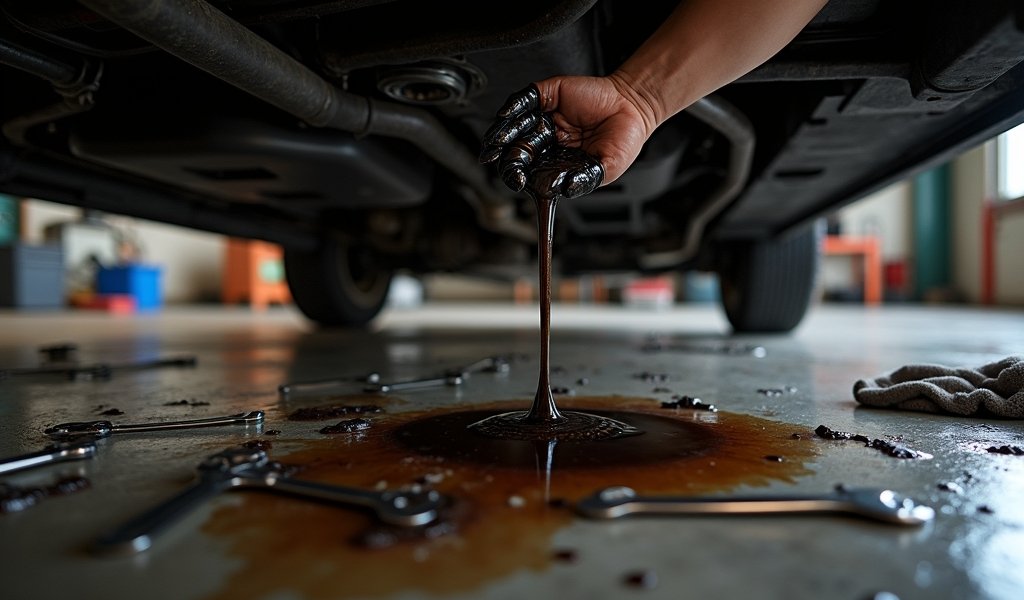Overview
This article explains how oil pan drain plug gaskets, though small, play a crucial role in preventing oil leaks, with recommendations for five top-quality options including Dorman, Fel-Pro, and Toyota Genuine Parts. It provides detailed guidance on identifying failing gaskets, proper replacement techniques, common installation mistakes to avoid, and maintenance tips to extend gasket life, emphasizing that quality gaskets and correct installation are essential for engine protection.
Table of Contents
- What Is an Oil Pan Drain Plug Gasket?
- Why Quality Matters in Drain Plug Gaskets
- Top 5 Oil Pan Drain Plug Gaskets in 2023
- Signs Your Drain Plug Gasket Is Failing
- How to Replace Your Oil Pan Drain Plug Gasket
- Common Mistakes When Replacing Drain Plug Gaskets
- Maintenance Tips to Extend Gasket Life
- Conclusion
- Frequently Asked Questions
What Is an Oil Pan Drain Plug Gasket?
An oil pan drain plug gasket is that tiny ring-shaped component that creates a seal between your oil pan and drain plug. I know it seems insignificant—barely bigger than a quarter in most cases—but this humble part prevents oil leaks from the bottom of your engine. As someone who’s been elbow-deep in engine oil for over 15 years, I can tell you this small gasket plays an outsized role in your vehicle’s maintenance.
Made typically from fiber, copper, aluminum, nylon, or rubber compounds, these gaskets ensure that when you tighten your drain plug during an oil change, you get a leak-free seal. The right oil pan drain plug gasket creates the perfect balance: tight enough to prevent leaks but not so tight that you strip threads or damage the oil pan during future oil changes.
Many folks overlook this component, thinking “it’s just a washer.” But trust me—skimping on quality here can lead to frustrating drips on your garage floor or, worse, dangerous oil loss while driving. That small puddle of oil under your vehicle after an oil change? Often the result of an improperly sealed drain plug or worn gasket.
Let’s look at why selecting the right drain plug gasket matters more than you might think, and which ones deserve your consideration when it’s time for replacement.
Why Quality Matters in Drain Plug Gaskets
I’ve seen plenty of car owners grimace at spending more than a few cents on a drain plug gasket. “It’s just a washer,” they say. But here’s why that thinking can cost you more in the long run.
A quality oil pan drain plug gasket prevents leaks that waste expensive synthetic oil and potentially cause environmental hazards. More importantly, it provides peace of mind. Nothing’s worse than completing an oil change only to find a slow drip the next morning—and then having to crawl back under your vehicle to fix it.
Premium gaskets also protect your oil pan threads. Cheap gaskets often require overtightening to seal properly, which can strip the delicate threads on your oil pan—a repair that might run hundreds of dollars. Quality gaskets seal correctly at the manufacturer’s recommended torque specifications.
Temperature resistance is another critical factor. Your engine oil can reach temperatures of 220°F or higher during operation. Inferior gaskets may break down under this heat, leading to unexpected failures between scheduled oil changes. High-quality gaskets maintain their sealing properties across the full temperature range your engine experiences.
According to research published by the Society of Automotive Engineers, proper gasket selection and installation can extend drain plug life significantly and reduce the environmental impact of improperly disposed motor oil.
Finally, reusability matters for those who change their own oil. Premium gaskets often allow for multiple uses, saving you money and hassle over time. Bargain options typically need replacement with each oil change.

Top 5 Oil Pan Drain Plug Gaskets in 2023
1. Dorman AutoGrade Copper Drain Plug Gasket Kit
Dorman’s copper gaskets have saved me countless headaches over the years. These copper washers provide excellent heat resistance and conform perfectly to both the drain plug and oil pan surfaces. The kit includes multiple sizes, making it versatile for different vehicles in your household.
What makes these stand out is their reusability—copper’s malleability allows it to create a fresh seal even after being torqued previously. I’ve regularly gotten 3-4 oil changes from a single gasket. They’re particularly well-suited for aluminum oil pans where thread protection is crucial.
The only drawback? They’re slightly more expensive than basic fiber washers, but the extended service life more than compensates for the initial investment.
2. Fel-Pro Oil Drain Plug Gasket
When I recommend gaskets to professional mechanics, Fel-Pro often tops my list. Their oil pan drain plug gaskets feature proprietary materials that resist both high temperatures and the chemical composition of modern synthetic oils.
What impresses me most is their consistency—every gasket in the package performs identically, which matters when you’re servicing multiple vehicles. The precision manufacturing ensures the gasket sits perfectly centered on the drain plug without slipping during installation.
These gaskets create reliable seals at lower torque values, helping protect oil pan threads while still preventing leaks. For high-mileage vehicles where the drain plug area might have slight wear, these gaskets are remarkably forgiving.
3. Fumoto Valve Replacement Gaskets
For those who’ve upgraded to Fumoto quick-drain valves (a fantastic investment for DIYers), their proprietary gaskets deserve serious consideration. These gaskets are specifically engineered for the unique design of quick-drain valves and provide exceptional sealing characteristics.
The silicone-based compound retains elasticity far longer than conventional gaskets, often lasting through 5+ oil changes before needing replacement. They’re also remarkably resistant to the hardening that plagues many rubber gaskets.
While they’re only compatible with Fumoto valves, they’re the clear choice if you’ve invested in this oil change convenience upgrade.
4. Toyota Genuine Parts Drain Plug Gasket
Sometimes OEM parts simply outperform aftermarket alternatives, and Toyota’s drain plug gaskets fall into this category. These fiber-composite gaskets provide excellent sealing characteristics while compressing just enough to prevent overtightening.
What’s noteworthy is their consistency batch-to-batch—something I’ve found lacking in some aftermarket brands. Though primarily designed for Toyota vehicles, their standard sizing makes them compatible with many other Japanese and domestic models.
While slightly pricier than generic options, their reliability makes them worth considering, especially if you’re experiencing persistent sealing issues with other brands.
5. NAPA Synthetic Rubber Drain Plug Gasket
NAPA’s synthetic rubber gaskets offer an excellent balance of performance and value. Their composition specifically addresses oil compatibility issues that can cause premature deterioration in conventional rubber gaskets.
I appreciate their thickness—substantial enough to create a positive seal but not so thick that they affect drain plug engagement. For vehicles with slightly worn drain plug threads, these gaskets often create reliable seals where thinner options fail.
While they typically need replacement with each oil change, their modest price and reliable performance make them a smart choice for routine maintenance.
Signs Your Drain Plug Gasket Is Failing
Even the best gaskets eventually wear out. Catching the warning signs early can save you from messy cleanup and potential engine damage. Here’s what to watch for:
The most obvious indicator is visible leaking around the drain plug area. This typically appears as a small wet spot directly beneath the oil pan after your vehicle has been parked overnight. If the leak is coming from the drain plug rather than elsewhere, you’ll notice oil residue specifically around the plug itself.
Another tell-tale sign is a gradual decrease in oil level between changes. If you’re checking your oil regularly (as you should), and notice it’s dropping faster than usual without any other symptoms, your drain plug gasket might be allowing a slow seep that’s not obvious enough to create visible drips.
Physical inspection can reveal problems too. During oil changes, examine the gasket closely. Look for compression set (where the gasket no longer springs back to its original shape), cracks, hardening, or deterioration. Any of these conditions indicates it’s time for replacement.
Some vehicle owners report a burning oil smell when a drain plug gasket begins to fail. This occurs when small amounts of leaking oil hit hot exhaust components. If you notice this smell, particularly after driving, inspect your drain plug area promptly.
One subtle indication that professionals watch for is dirt accumulation around the drain plug. Oil acts as a dust magnet, so even minor seepage will create a buildup of grime in the area. If your drain plug looks significantly dirtier than surrounding components, suspect a failing gasket.
Before planning your next oil change before a long drive, inspect these areas carefully to avoid potential issues on your journey.
How to Replace Your Oil Pan Drain Plug Gasket
Replacing your oil pan drain plug gasket is straightforward, even for novice DIYers. Here’s my step-by-step approach after years of performing this task:
First, gather your supplies: the correct replacement gasket, basic hand tools, a drain pan, and cleaning materials. Wait until your engine is warm (not hot) for easier oil flow, but cool enough to touch safely.
Position your drain pan beneath the oil drain plug. Using the appropriate wrench size (typically 14mm-17mm), loosen the drain plug counterclockwise. Be prepared for oil flow as it loosens. Remove the plug completely, allowing oil to drain fully—this usually takes 5-10 minutes.
Once drained, examine the drain plug and its threads carefully. Look for damage, crossed threads, or metal shavings that might indicate internal engine problems. Clean the drain plug thoroughly with a lint-free cloth.
Remove the old gasket completely. Sometimes they stick to the oil pan rather than staying on the plug. Ensure all remnants of the old gasket are removed to prevent double-gasketing (a common cause of leaks).
Inspect the sealing surface on the oil pan for damage or irregularities. A perfectly smooth surface is essential for proper sealing. Minor scratches can sometimes be carefully smoothed with fine-grit sandpaper if necessary.
Install the new gasket onto the drain plug. Most gaskets have a specific orientation—the flatter side typically faces the oil pan while any beveled edge faces the plug head. Reference your vehicle’s service manual if you’re uncertain.
Thread the drain plug in by hand initially to prevent cross-threading. Once finger-tight, use your wrench to apply the final torque. Most vehicles specify between 20-30 ft-lbs, but check your specific model’s requirements. Over-tightening can damage the oil pan threads or crush the gasket excessively.
After completing your oil change, start the engine and let it run for a minute, then shut it off and check for leaks. A properly installed gasket should provide a perfect seal immediately.

Common Mistakes When Replacing Drain Plug Gaskets
Even experienced DIYers sometimes make errors when dealing with drain plug gaskets. Here are the pitfalls I’ve observed (and occasionally committed myself) over years of oil changes:
Double-gasketing is perhaps the most common mistake. This occurs when you install a new gasket without completely removing the old one, creating an imperfect seal that almost always leaks. Always verify the old gasket has been completely removed from both the drain plug and the oil pan.
Reusing old gaskets is tempting but risky. Once compressed, most gaskets (except certain copper and aluminum types) lose their ability to create a proper seal. What saves you a dollar now might cost you quarts of oil and hours of cleanup later.
Incorrect torquing ranks high on the mistake list. Over-tightening doesn’t create a better seal—it crushes the gasket beyond its functional limits and can damage oil pan threads. Under-tightening, meanwhile, rarely creates a sufficient seal. Invest in an inexpensive torque wrench and use your vehicle’s specifications.
Using the wrong gasket material for your application leads to premature failure. For example, basic rubber gaskets often deteriorate quickly in synthetic oil, while some fiber gaskets perform poorly with conventional oil. Match your gasket material to your oil type and driving conditions.
Neglecting to clean the sealing surfaces properly invites leaks. Even tiny debris particles can prevent proper gasket seating. Take the extra minute to wipe both the drain plug and oil pan surfaces thoroughly before installation.
Cross-threading the drain plug during reinstallation can cause extensive damage. Always start threading by hand, and if you feel any resistance, back out and try again rather than forcing it.
According to Consumer Reports’ maintenance experts, improper drain plug installation ranks among the most common causes of engine oil leaks following service.
Maintenance Tips to Extend Gasket Life
While drain plug gaskets are considered maintenance items, several practices can help maximize their service life:
- Apply the correct torque every time. Over-tightening doesn’t prevent leaks—it damages gaskets and threads.
- Keep a maintenance log tracking when you’ve reused gaskets. Most quality gaskets can handle 2-3 cycles before needing replacement.
- Consider upgrading to a magnetic drain plug that attracts metal particles, reducing wear on the gasket sealing surface.
- When performing oil changes, wipe the drain plug area clean before removal to prevent contaminants from reaching the gasket surface.
- Store spare gaskets in a clean, cool environment away from chemicals, sunlight, and extreme temperatures that can degrade their materials.
For vehicles driven in extreme conditions—whether frequent short trips, very hot climates, or dusty environments—inspect your drain plug area more frequently. These conditions accelerate gasket deterioration.
If you’re comfortable with slight modifications, consider applying a thin film of appropriate gasket sealant to fiber gaskets in troublesome applications. This can extend service life, though isn’t necessary with most quality gaskets under normal conditions.
For those who change their own oil, invest in a proper drain plug wrench rather than using adjustable wrenches or pliers, which can damage the plug head and indirectly affect gasket seating.
Finally, consider upgrading to a quick-drain valve system if you perform frequent oil changes. These systems eliminate the need for repeatedly removing and reinstalling the drain plug, preserving both the plug and pan threads that affect gasket seating.
Conclusion
The humble oil pan drain plug gasket might be small, but its importance can’t be overstated in maintaining your vehicle’s health. From preventing messy leaks to protecting expensive engine components, this simple part delivers significant value for minimal cost.
Whether you opt for the versatility of Dorman’s copper gaskets, the reliability of Fel-Pro, the longevity of Fumoto’s offerings, the precision of Toyota OEM parts, or the value of NAPA’s synthetic rubber gaskets, choosing quality makes all the difference. The small premium for better components pays dividends in convenience, cleanliness, and peace of mind.
Remember that proper installation techniques matter just as much as the gasket you select. Take the time to clean surfaces thoroughly, apply correct torque, and verify the seal after completion. These small steps can prevent frustrating leaks and potential environmental hazards.
For DIY enthusiasts, treating drain plug gasket replacement with the same care you’d give more complex maintenance tasks ensures your oil changes deliver the full benefit and protection your engine deserves. After all, even the highest-quality oil can’t protect your engine if it’s slowly dripping onto your driveway.
The next time you’re planning an oil change, give some thought to this often-overlooked component. Your engine—and your garage floor—will thank you.
Frequently Asked Questions
How often should I replace my oil pan drain plug gasket?
Replace fiber and rubber gaskets with every oil change. Higher-quality copper and aluminum gaskets can often last through 2-3 oil changes if carefully removed and not deformed.
Can I reuse my old drain plug gasket?
While copper and aluminum gaskets can sometimes be reused, it’s generally not recommended for most types. The minimal cost of a new gasket is cheap insurance against potential leaks.
What’s the difference between crush washers and regular gaskets?
Crush washers are designed to deform permanently when tightened, creating a custom seal. Regular gaskets maintain some elasticity and can sometimes be reused depending on the material.
Why is my new drain plug gasket still leaking?
Common causes include improper torque, damaged sealing surfaces, wrong gasket size, or debris trapped between sealing surfaces. Inspect each of these factors when troubleshooting.
Do I need a special gasket for synthetic oil?
While not always required, gaskets specifically rated for synthetic oil resist chemical breakdown better. Materials like Viton rubber and certain composites offer superior compatibility with synthetic formulations.

